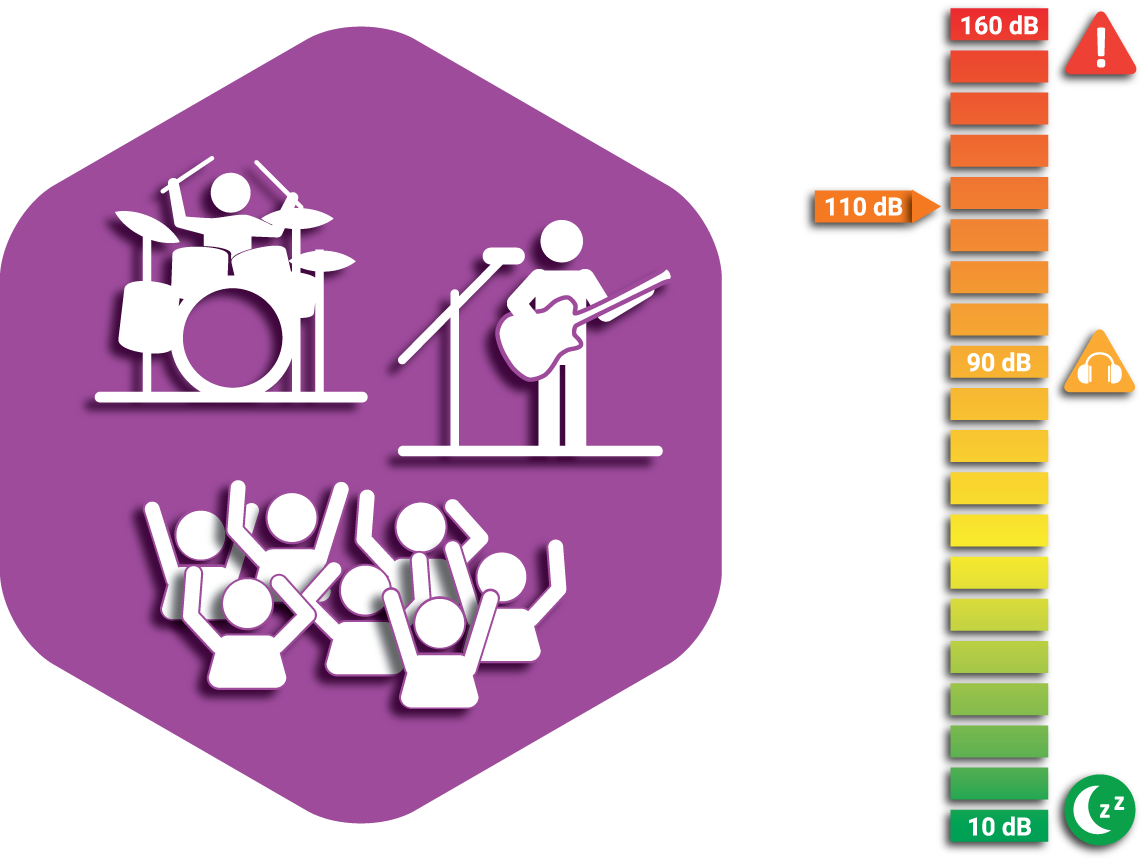- Soft ambient music: 30 dB(A)
- Average radio (5m from the observer): 75 dB(A)
- School dance: 100 dB(A)
- Average rock concert: 115 dB(A)
- Loud symphony: 120 dB(A)
- Sports crowd: 120 dB(A)
- Normal piano practice: 60-70 dB(A)
- Chamber music (small auditorium): 75-85 dB(A)
- Piano (fortissimo): 85-105 dB(A)
- Violin: 82-92 dB(A)
- Cello: 85-110 dB(A)
- Oboe: 95-110 dB(A)
- Flute: 90-105 dB(A)
- Piccolo: 90-105 dB(A)
- Clarinet: 85-115 dB(A)
- French horn: 90-105 dB(A)
- Trombone: 85-115 dB(A)
- Bass drum: 100-105 dB(A)
- Symphonic music peak: 120-135 dB(A)
- Amplifier, rock music (5m from the observer): 120 dB(A)
- Rock music peak (5m from the observer): 150 dB(A)
Airport and Aircraft Noise

Average SPL: 130 dB(A)
aircraft enging type: jet engine
distance from the observer: ≥50m
As for the airplane noise, a series of factors must be taken into account: airplane type, payload, trajectory, phase of flight (takeoff, landing, normal flight), weather conditions. Multiple components contribute to the overall noise emitted by an aircraft: aerodynamic, engine and propulsion mechanisms, aircraft mechanical systems along the airframe (e.g., wings, flaps, landing gears).
Other sound sources can be identified within an airport, such as maintenance and emergency vehicles, acoustic signaling systems, baggage and passenger transportation systems, etc.
If we want to examine aircraft noise in much more detail, we have to start from its engine and propulsion mechanisms. Propeller engines (as well as helicopter rotors) produces narrow-band and high intensity peaks related to the rotational speed of the moving parts of the propellers. Gas turbine engines (i.e., jet engines) are the most significant noise sources during the takeoff and climb phases. The sound pressure level (SPL) of a jet noise is directly proportional to the jet speed.
The aerodynamic noise is given by the flow of the air alongside the plane fuselage. It is determined by a combination of factors: shape of the fuselage; presence of extruded windshields or canopies; shape, size and position of engines; shape, size and number of blades in propeller engines and rotors; shape, size and position of wings, flaps, ailerons; shape, size and position of tail. The aerodynamic noise is directly proportional to the aircraft speed and to the altitude decrease (higher noises are produced at low altitudes, due to the higher air density).
The airframe also contributes to the overall noise emitted by an airplane, especially during the landing phase: wings, flaps and landing gears produce sharp, low frequency peaks especially audible from the ground when the airplane is approaching.
Other noise emissions can be typically heard along the airport takeoff routes: these are represented by the so-called engine run-up tests. The run-up are systematic engine checks that have to be performed in order to ascertain that the aircraft engines are working properly and that the onboard instrumentation are metering properly the engine behavior. Engine run-ups are performed before the takeoff and vary depending on the engine types (propeller engines require longer run-ups).
As a reference, we can consider the following SPL average values:
- Jet engine at takeoff (20m from the observer, atmospheric pressure): 200 dB(A)
- Jet engine at takeoff (50m from the observer, atmospheric pressure): 130 dB(A)
- Propeller engine (30m overhead): 140dB(A)
Concert Noise

Average SPL: 110 dB(A)
Rock concert
distance from the observer: ?5m
Recent tests activities performed during music festivals highlighted how the individual sound exposure per evening varied between 90 and 115 dB(A), with an average exposure of 100 dB(A) and prolonged peaks of 110 dB(A).
Modern rock and pop bands playing from a stage typically reach a noise level in the range 90-100 dB(A) for the audience placed at distances equals or greater than 15m from the stage. It is worth to mention that a 90dB(A) noise level exposure can induce damage if it lasts for 4 hours, while a 100dB(A) noise exposure can create permanent hearing losses and damages after only 2 hours.
As a reference, we can consider the following SPL average values at 15m from the observer, if not specified differently: